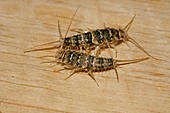
Life Cycle and Reproduction
Firebrats, which on average have a two to three year
lifespan, become sexually mature adults in anywhere from 3 to 24
months from hatching. The immature, or nymph, stage of
Thermobia domestica is very similar to the adult; there is
no metamorphosis between the two stages. From hatching as
a small egg, usually no larger than 1/25 inch, they grow through
a nymph stage right into adulthood where they may reach 1/2 inch
in length. Though they molt during these stages, there is
no true metamorphosis which takes place, and it takes several
molts before the adult scales develop. (Davies 1988)
Molting is a bit of a curiosity in the firebrat. Most
insects not only metamorphose, they also cease molting once they
reach adulthood or become sexually mature. (Hickman et al.
2009) This is not the
case with Thermobia domestica who tend to molt through
their entire lifespan. Molting occurs in these insects
through adulthood, and though series of cellular changes occur
there is no metamorphosis or cessation of molting to cue the
adult stage. (Lanham 1964)
Reproduction coincides with molting in a number of ways. Mating is restricted to the molting cycle, and males can only proposition females whose molting cycles are within three (in rare observed cases maybe four) days of the male's cycle. (Nijout 1994) It has been observed that firebrats mate with each and every instar (period between molts) and females lay eggs after every molt following. Females, who double in size after the onset of reproduction, will lay eggs in batches of as many as 50 or 60, and will produce up to 100 or more batches in a lifetime. (Lanham 1964) Being the flat and small organisms they are, firebrats will lay eggs in tiny cracks or crevices where they are secluded from disturbance. The eggs take less than two weeks to hatch, and aside from size and scales, nymphs (or juveniles) look like the adult. (Davies 1988)
One of the most interesting characteristics of Thermobia
domestica is their mating dance. Once it has been
determined a female is in the appropriate stage of an instar, a male
will approach her head-on repeatedly while shaking his head from
side to side. (Lanham 1964) He will sometimes come close enough to touch her
head, but not necessarily with every pass. The male will then
whirl in a circular motion, up-twisting his abdomen and turning his
head. The male will next walk past the female, intentionally
brushing her legs with his own, to which the female responds by
moving forward a small distance and turning her body around.
 From this point the dance repeats until the male is prepared to lay
a spermetaphore (sperm sac), which in one recorded case took half an
hour! When ready, the male lays one singular spermetaphore on
the ground just in front of the female. He speeds past her
then, again intentionally brushing her legs and causing her to move
forward. Only in this last dance, the female moves directly
over the sperm, and it is seized by her genitalia. This quirky
ritual has been likened to the mating dance of spiders, and one
author compares the entire reproductive process to that of
artificial insemination in humans. (Ordish 1960)
From this point the dance repeats until the male is prepared to lay
a spermetaphore (sperm sac), which in one recorded case took half an
hour! When ready, the male lays one singular spermetaphore on
the ground just in front of the female. He speeds past her
then, again intentionally brushing her legs and causing her to move
forward. Only in this last dance, the female moves directly
over the sperm, and it is seized by her genitalia. This quirky
ritual has been likened to the mating dance of spiders, and one
author compares the entire reproductive process to that of
artificial insemination in humans. (Ordish 1960)